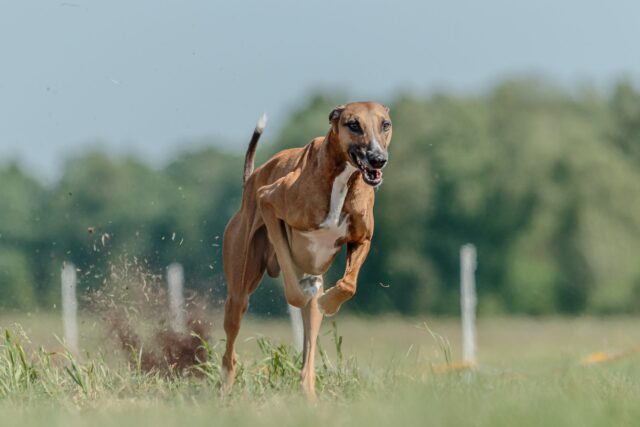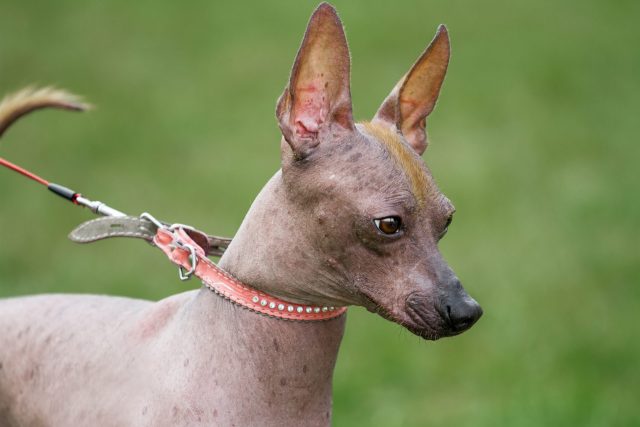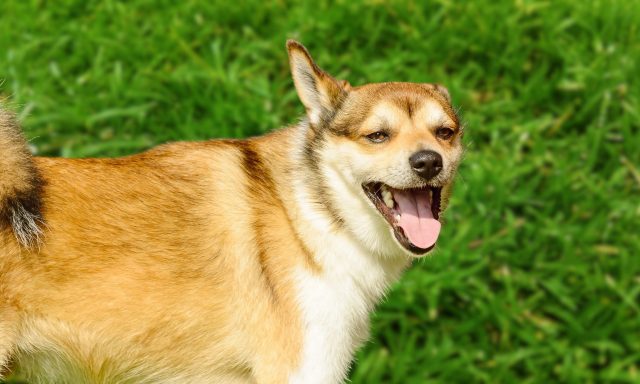6. Mudi
The Mudi is a rare herding breed from Hungary that is highly prized for its versatility, intelligence, and agility. Despite being virtually unknown outside of its native country, the Mudi is an exceptional working dog capable of herding livestock, guarding property, and even hunting. This medium-sized breed is known for its distinctive curly coat, which comes in a variety of colors, including black, white, and merle. Mudis are highly energetic and require plenty of physical and mental stimulation, making them ideal for active owners who enjoy dog sports like agility, obedience, and herding trials. Their strong work ethic and loyalty to their owners make them excellent companions, though they may be reserved with strangers. The Mudi’s rarity and unique skill set make it a breed worth discovering, especially for those looking for a capable and loyal working dog.
5. Thai Ridgeback
The Thai Ridgeback is a rare and ancient breed from Thailand. It is known for its distinctive ridge of hair running along its back, which is similar to the more well-known Rhodesian Ridgeback. This breed has been used for centuries in Thailand as a hunting and guard dog, valued for its strength, agility, and independence. Thai Ridgebacks are medium to large-sized dogs with a sleek, muscular build and a short, dense coat that comes in a variety of colors, including red, black, blue, and fawn. They are known for their loyalty to their families and their strong protective instincts, making them excellent guard dogs. However, their independent nature can make it challenging for them to train, and they require an experienced owner who can provide consistent leadership and socialization. The Thai Ridgeback’s unique appearance and ancient lineage make it a fascinating breed that remains relatively unknown outside of its homeland.

4. Azawakh
The Azawakh is a rare sighthound breed from West Africa, known for its elegant, slender build and incredible speed. This breed has been used by nomadic tribes in the Sahel region for centuries to hunt, game, and protect livestock. Azawakhs are tall, lean dogs with a short coat that comes in various colors, including sand, red, blue, and brindle. Despite their delicate appearance, Azawakhs are incredibly tough and resilient, able to withstand the harsh conditions of the African desert. They are known for their strong bond with their owners and can be reserved or aloof with strangers. Azawakhs require plenty of exercise and thrive in environments where they can run and stretch their legs. Their rarity and unique combination of elegance and strength make the Azawakh a breed that stands out among sighthounds, yet it remains largely unknown outside of its native region.

3. Lagotto Romagnolo
The Lagotto Romagnolo is an ancient Italian breed known for its exceptional truffle-hunting abilities. Originating from the Romagna region of Italy, this medium-sized dog has a dense, curly coat that is both waterproof and hypoallergenic, making it well-suited to working in damp environments. The Lagotto Romagnolo was originally bred as a water retriever, but over time, it became specialized in truffle hunting due to its keen sense of smell and strong work ethic. Despite its rich history and unique skills, the Lagotto Romagnolo remains relatively rare outside of Italy. These dogs are intelligent, affectionate, and highly trainable, making them excellent companions for those who appreciate their working background and are willing to provide the mental stimulation they need.

2. Peruvian Inca Orchid
The Peruvian Inca Orchid, also known as the Peruvian Hairless Dog, is an ancient and rare breed from Peru, known for its unique appearance and rich cultural history. This breed is often hairless, though there are also coated varieties, and its skin can come in a variety of colors, including black, brown, pink, and grey. The Peruvian Inca Orchid has been revered in Peruvian culture for centuries, often depicted in ancient art and considered a sacred animal. These dogs are known for their affectionate and loyal nature, forming strong bonds with their owners. They are also highly intelligent and require mental stimulation to stay happy. Due to their lack of hair, they are sensitive to extreme temperatures and require special care to protect their skin. The Peruvian Inca Orchid’s rarity, combined with its striking appearance and cultural significance, makes it a breed that stands out, yet it remains relatively unknown outside of its native country.

1. Norwegian Lundehund
The Norwegian Lundehund is a truly unique and rare breed from Norway, known for its extraordinary physical characteristics that make it unlike any other dog breed. Originally bred to hunt puffins along the rocky cliffs of Norway, the Lundehund has several unique adaptations that make it perfectly suited for this task. These include six toes on each foot, the ability to bend its neck backward to touch its spine, and unusually flexible shoulders that allow it to climb and navigate steep terrain. The Norwegian Lundehund is a small, agile dog with a dense double coat that protects it from the harsh Norwegian climate. Despite its remarkable abilities, the Lundehund is incredibly rare, even in its native country, and is at risk of extinction due to its small population. This breed is known for its loyalty and playful nature, but it can be wary of strangers and requires early socialization. The Norwegian Lundehund’s combination of rarity, unique physical traits, and historical significance makes it a breed like no other, yet it remains largely unknown to the broader public.

These rare dog breeds each bring something unique to the world of dogs, whether through their physical characteristics, historical significance, or specialized abilities. Despite their rarity, these breeds have much to offer and deserve more recognition and appreciation. Whether you’re a dog enthusiast looking to expand your knowledge or someone considering a rare breed as a companion, these breeds highlight the incredible diversity and richness of the canine world. By learning more about these lesser-known breeds, we can help ensure their preservation and continued contribution to the fascinating world of dogs.






